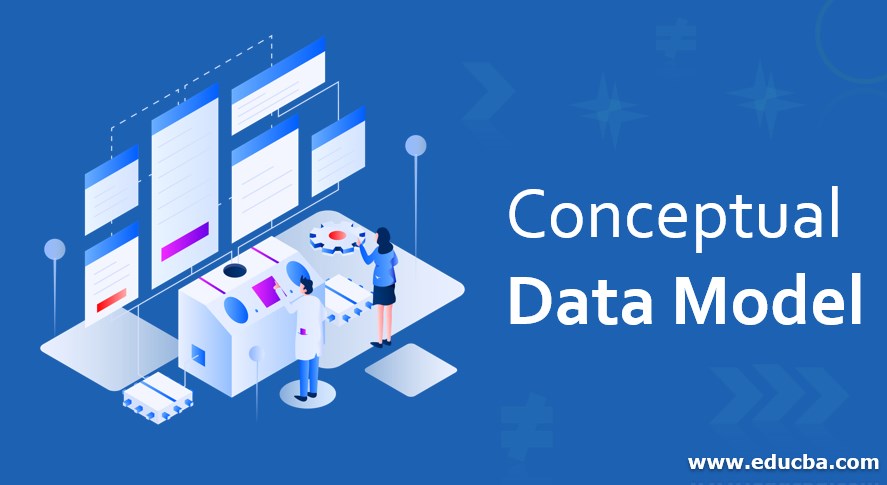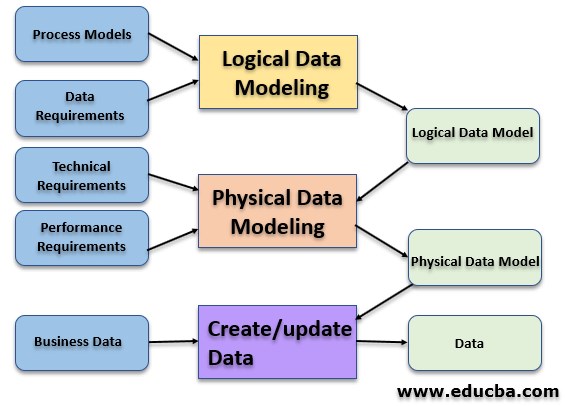Updated July 6, 2023

Introduction to Conceptual Data Model
Whenever there is data there is always a requirement to store data in the database. The data model is used to represent the data objects in the database, the association between the data objects, and also rules. The data model defines rules to store the data in the database. The data model is of three categories i.e. conceptual, logical, and physical. It is used to define what the actual system contains. This is basically sued by data architects and business stakeholders. It is used to define the scope and manage business rules and concepts.
What is Conceptual Data Model?
It is used to provide information about business rules and business concepts that can be developed by business domain people. This model is used to define the relationship and the data entities which are used by the model. The entity can be defined as a real-world object whereas the relationship is the dependency between any two entities.
It is mostly used to represent these relationships and entities. The organizations basically use this model to get a wider idea of business concepts and better understand the system. This model is basically developed independently of any hardware specifications. The specifications include location, software specifications, or data storage capacity. The other name for the conceptual data model is a business model.
As the conceptual data model is of high level it usually not contains attributes in its structure. This model is used to define the relationship among the data entities but does not provide information about cardinality properties. The aim of the conceptual data model is to define a model that is independent of any database management system or any database technology. This model is usually constructed initially which covers the initial requirements and also contains high-level concepts for defining the business structures.
The other use of the conceptual data model is to identify system entities, high-level key business, and defining the relationship that exists among the data entities. It is used to fill the gap between the requirement document and the solution model. It contains the business concepts which can be designed by the business analysts.
What is Data Model?
The data model means the logical relationships and the data which flow between various data elements. The data model is used to define the process of data storage and retrieved from the database. The data models are mostly used to figure out the requirements of the information system and also design the response of all those requirements. The data models help to represent the data, what data format needs to be used as the format varies according to the business process.
The data models are present in abstract form. The components of the data model are data types, data items, data sources, links, and event sources. The data modeling notation is used to represent the data models which is mostly presented in graphical format. The data models are sued to define the proper format of data as the data can be presented in various other formats. As the data model is capable of defining the relationship among the database tables it has its own significance when data is stored in a database. The database operations are easily carried out using the data models.
Uses
Here are some of the uses of data model explained below:
- The entities and concepts are defined by using this model. All the important entities and relationships are initially find out by using this model.
- The project scope is defined by a conceptual data model. By defining the project scope the time scheduling and time management can be properly managed.
- The conceptual data model is used to get a high-level understanding of the system throughout the complete software development lifecycle. By using the conceptual model the business executives and business managers can understand the system easily and will get a high level of knowledge about the system.
Uses of Data Model
Let us see some of the uses of data models which are as follows:
- It is used to represent all the data objects in the database accurately. If any data is omitted it can create problems while performing database operations.
- The data model helps to represent the data in logical and physical levels. ‘
- The relational tables, foreign and primary keys are all defined by the data models.
- The data redundancy can be eliminated from the database as the data model can easily identify the redundant data. The data models can also be used to identify the missing data and can take appropriate actions according to that.
- As the data models help to represent the data virtually the developers use this virtual representation to create an actual database from that.
- Using the data models while creating the database helps to maintain the database and helps to upgrade the database with fewer efforts.
Types of Data Model
Let see the types of data models which are given below:
1. Conceptual
This type of data model is used to define what the system actually contains. The conceptual data model is mostly used by data architects and business stakeholders. The business concepts and the business rules are managed by using the conceptual data model.
2. Logical
This type of data model is used to define how the system will actually implement without knowing the database management system. The logical data model is developed by business analysts and data architects. The data structures and implementation rules are defined in this model.
3. Physical
This type of data model is used to define how the system will actually implement without knowing the database management system. The physical data model is developed by database developers and database administrators. The physical data model is used to actually implement the database.
Conclusion
The conceptual data model is basically used by the data architects to get the idea at a higher level of the system. The conceptual data model basically contains three tenants entity, attribute, and relationship. The model does not include detailed information about entities and relationships use in the system it contains only high-level information. The conceptual model contains high-level detail for any database structure.
Recommended Articles
This is a guide to the Conceptual Data Model. Here we discuss what is data model along with its uses and different types of Conceptual Data Model. You may also have a look at the following articles to learn more –

